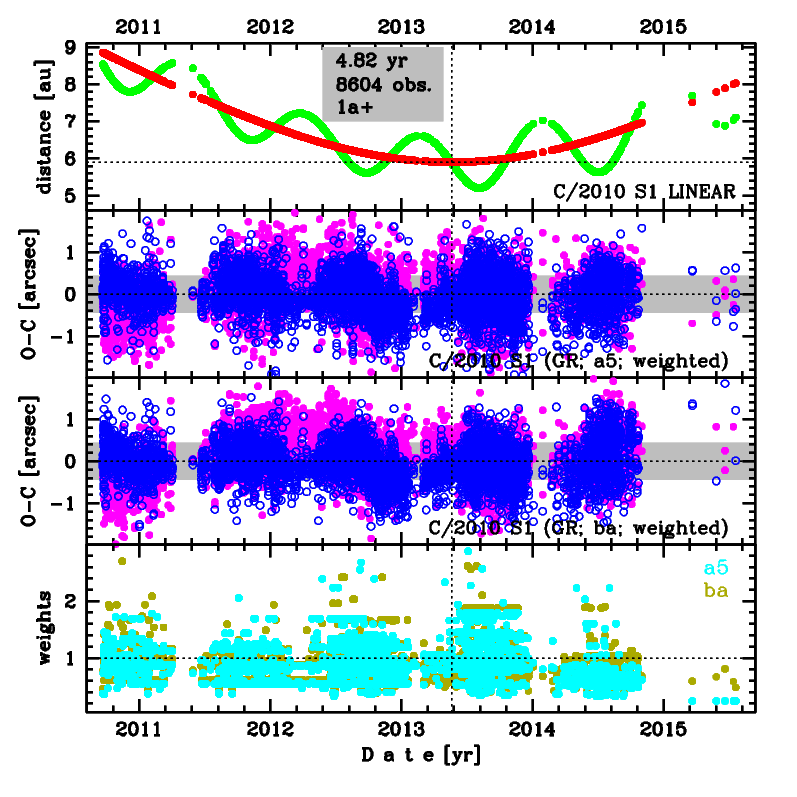C/2010 S1 LINEAR
more info
Comet C/2010 S1 was discovered on 21 September 2010 and next observed almost continuously by 4.8 yr in a range of heliocentric distances: 8.85 au – 5.900 au (perihelion) – 8.02 au. At the moment of discovery, it was two years and eight months before perihelion passage (see figure).
Comet had its closest approach to the Earth on 4 August 2013 (5.205 au, 2.5 months after perihelion).
NG orbit is possible to obtained using the full data arc; however uncertainties of NG parameters are notable, especially for A2 (see solutions ac and bc differing only in data weighting).
This Oort spike comet suffers a tiny planetary perturbations during its passage through the planetary system.
See also Królikowska and Dones 2023 and Królikowska and Dybczyński 2017.
Comet had its closest approach to the Earth on 4 August 2013 (5.205 au, 2.5 months after perihelion).
NG orbit is possible to obtained using the full data arc; however uncertainties of NG parameters are notable, especially for A2 (see solutions ac and bc differing only in data weighting).
This Oort spike comet suffers a tiny planetary perturbations during its passage through the planetary system.
See also Królikowska and Dones 2023 and Królikowska and Dybczyński 2017.
| solution description | ||
|---|---|---|
| number of observations | 8579 | |
| data interval | 2010 09 21 – 2015 07 19 | |
| data type | perihelion within the observation arc (FULL) | |
| data arc selection | entire data set (STD) | |
| range of heliocentric distances | 8.85 au – 5.90 au (perihelion) – 8.02 au | |
| detectability of NG effects in the comet's motion | comet with determinable NG~orbit | |
| type of model of motion | GR - gravitational orbit | |
| data weighting | YES | |
| number of residuals | 17046 | |
| RMS [arcseconds] | 0.44 | |
| orbit quality class | 1a+ | |
| next orbit statistics, both Galactic and stellar perturbations were taken into account | ||
|---|---|---|
| no. of returning VCs in the swarm | 5001 | * |
| no. of escaping VCs in the swarm | 0 | |
| no. of hyperbolas among escaping VCs in the swarm | 0 | |
| next reciprocal semi-major axis [10-6 au-1] | 71.95 – 72.38 – 72.82 | |
| next perihelion distance [au] | 87.4 – 90.4 – 93 | |
| next aphelion distance [103 au] | 27.38 – 27.54 – 27.7 | |
| time interval to next perihelion [Myr] | 1.482 – 1.487 – 1.492 | |
| percentage of VCs with qnext > 20 | 100 | |

Upper panel: Time distribution of positional observations with corresponding heliocentric (red curve) and geocentric (green curve) distance at which they were taken. The horizontal dotted line shows the perihelion distance for a given comet whereas vertical dotted line — the moment of perihelion passage.
Middle panel(s): O-C diagram for a given solution (sometimes in comparison to another solution available in CODE), where residuals in right ascension are shown using magenta dots and in declination by blue open circles.
Lowest panel: Relative weights for a given data set(s).
Middle panel(s): O-C diagram for a given solution (sometimes in comparison to another solution available in CODE), where residuals in right ascension are shown using magenta dots and in declination by blue open circles.
Lowest panel: Relative weights for a given data set(s).
| next_g orbit statistics, here only the Galactic tide has been included | ||
|---|---|---|
| no. of returning VCs in the swarm | 5001 | * |
| no. of escaping VCs in the swarm | 0 | |
| no. of hyperbolas among escaping VCs in the swarm | 0 | |
| next reciprocal semi-major axis [10-6 au-1] | 76.45 – 76.65 – 76.84 | |
| next perihelion distance [au] | 6.0894 – 6.0911 – 6.0928 | |
| next aphelion distance [103 au] | 26.02 – 26.09 – 26.16 | |
| time interval to next perihelion [Myr] | 1.483 – 1.488 – 1.494 | |
| percentage of VCs with qnext < 10 | 100 | |